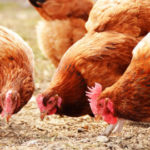Growing termites or providing conditions so you can collect them is an old way of feeding chicken in traditional African society but which we must revive to provide our chicken with a very rich source of protein like no other. Any farmer who can ensure a continuous supply of termites or ants to his flock ends up with very healthy and happy chicken.
You might have seen termites under rotting trees long abandoned, among pieces of decaying clothes, traditional pots or any bio-degradable matter.
There are a number of steps a farmer can follow to raise thousands of termites that enough to supply all the supplemental protein needs of her chicken.
- Look for an old container shaped piece of wood like a wooden tomato crate or traditional pot. This could be a pot that is already broken and cannot hold water but can hold dry matter. Anything that can help with absorption of moisture can very comfortably be used for this undertaking as it will keep the inside cool and habitable for the termites to thrive and stay in there for harvesting. This means the farmer should avoid any plastic containers or any container that does not facilitate the free flow of air either directly or through slow absorption via pores. It is instructive to recognize that the African household has so many homemade containers that can be used for this purpose like those woven using grass, sisal or papyrus reeds among others.
- Go round your home gathering all rotten, dry organic matter and place in the pot. These could be pieces of dry abandoned and dirty cotton clothes that have become dirty in the garden, fallen dry leaves, dry cow dung, dry maize husks etc. Take great care not to mix in there leaves that are still green or wet cow dung as these will frustrate the process and growth of the termites. The next step to make layers in the pot with your collections only adding a little soil. Care should be taken not to stuff soil or all that you have collected that makes air flow curtailed. Place the old cotton clothes, add a little soil then sprinkle water around the layer and to the walls. Prepare another layer, and another according to the size of your container making sure the inside of the container never becomes wet, only moist. After this is done, turn the container with the mouth facing down (downside up)and place it where there is no frequent movement of humans like behind your house or near the chicken house. Then leave it for a period of three to four days. Always take care to sprinkle water at the back of the pot if the weather is hot as it is the moist condition that is conducive for the growth and retention of the termites.
- Harvesting: The duty of the farmer while the container is inverted is to turn up the ‘factory’ and check if there are termites. If no termites are found and if they are still very few, take it to its former position and wait for one more day or two taking care to sprinkle water at the back if the weather conditions are not favourable, i.e. dry. If finally you find lots of termites, slowly remove the contents of the pot and release to the chicken. They will happily approach you and it is normally a feast just as humans would happily do when invited to partake in their favourite meal.
- Repeat the same process to collect more termites for et another ‘diet change’ session with your flock. You can freely use the very same items you removed as they will still be holding some termites which will attract others to the pot. Make sure the inside of the container is moist, turn the container as previously instructed and leave for four days again.
Now you have you steady, reliable supply of proteins for your scavenging or caged chicken which they will like very much. This when supplemented with kitchen waste and a little scavenging ensures the rearing of very healthy and tasty chicken for your family and customers.
For more details, check out our Kienyeji chicken farming manual.


